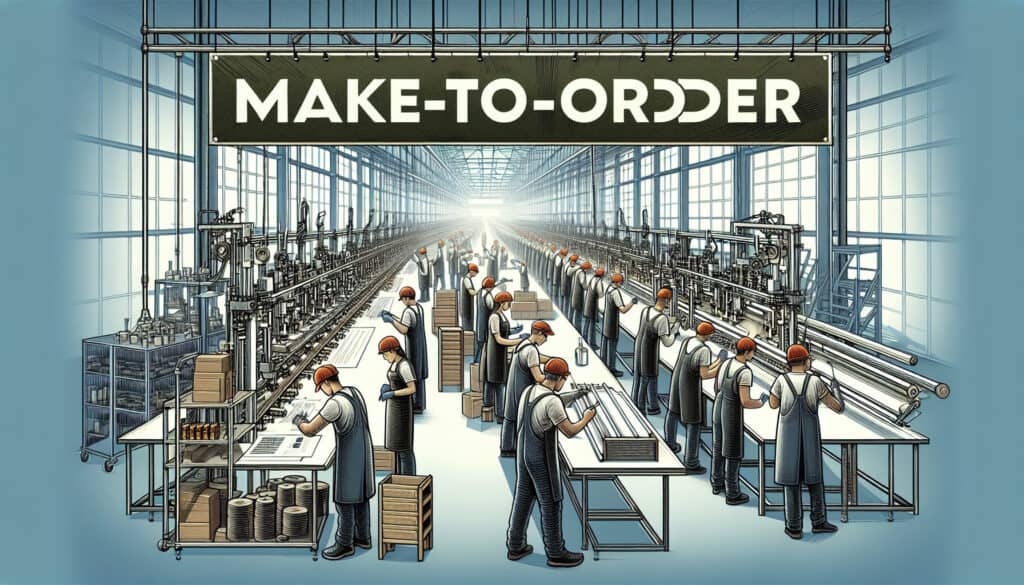Fabricar un producto sólo después de que un cliente haya hecho un pedido.
- Metodologías: Ingeniería, Calidad
Fabricación bajo pedido (MTO)

Fabricación bajo pedido (MTO)
- Fabricación aditiva, Justo a tiempo (JIT), Manufactura esbelta, Diseño de producto, Desarrollo de productos, Cadena de suministro, Prácticas de sostenibilidad, Propuesta de valor
Objetivo:
Cómo se utiliza:
- A manufacturing strategy where production is initiated only after a confirmed customer order is received. This allows for a high degree of customization and reduces the risk of unsold inventory.
Ventajas
- Allows for a high degree of customization; Reduces the risk of obsolescence and excess inventory.
Contras
- Longer lead times for customers; Can be difficult to manage fluctuating demand.
Categorías:
- Lean Sigma, Fabricación
Ideal para:
- Producing customized products such as high-end furniture, specialized machinery, or tailored clothing.
Make-to-Order (MTO) methodology is particularly effective in industries where customer preferences vary significantly and where the demand for unique products is strong, such as aerospace, automotive, custom machinery, and fashion design. This strategy can be implemented during various project phases, from design and prototyping to production and delivery. It necessitates close collaboration between designers, engineers, and clients to ensure that specifications are fully understood and met. MTO projects often involve the use of sophisticated customer relationship management tools and flexible manufacturing systems to adapt quickly to changing requirements, ensuring that products not only meet high standards but also align with clients’ evolving needs. Participants usually include sales teams who work directly with customers, design engineers who translate requests into specifications, and production teams skilled in handling custom builds. In applications like medical devices, where each product may need to conform to specific regulatory requirements, MTO provides a pathway to compliance while serving customer-specific demands. The iterative nature of the MTO process can also drive innovation, as customer feedback from early orders can inform the development of new products and improvements to existing lines, thus promoting a culture of continuous enhancement.
Pasos clave de esta metodología
- Receive confirmed customer order with product specifications.
- Review design requirements and feasibility of customization.
- Initiate production planning and resource allocation.
- Design prototypes or mock-ups as needed for approval.
- Commence manufacturing once designs are approved.
- Monitor production progress and quality control throughout.
- Make adjustments based on feedback or changes in specifications.
- Finalize product and prepare for delivery to the customer.
Consejos profesionales
- Implement advanced analytics for accurate demand forecasting, allowing for better resource allocation and scheduling.
- Enhance communication between sales and production teams to ensure alignment on customization options and production feasibility.
- Invest in modular design principles to facilitate efficient customization while minimizing lead times and production costs.
Leer y comparar varias metodologías, recomendamos el
> Amplio repositorio de metodologías <
junto con otras más de 400 metodologías.
Sus comentarios sobre esta metodología o información adicional son bienvenidos en la dirección sección de comentarios ↓ , así como cualquier idea o enlace relacionado con la ingeniería.
Contexto histórico
1949
1950
1950
1960
1960
1960
1960
1940
1950
1950
1958
1960
1960
1960
1960
(si se desconoce la fecha o no es relevante, por ejemplo "mecánica de fluidos", se ofrece una estimación redondeada de su notable aparición)















Publicaciones relacionadas
Gestión de operaciones de fabricación (MOM)
Sistema de Ejecución de Fabricación (MES)
Plan de control de la fabricación
Pruebas manuales
Tablas de evaluación de la manipulación manual (MAC)
ManTRA (Herramienta de evaluación de riesgos en las tareas manuales)